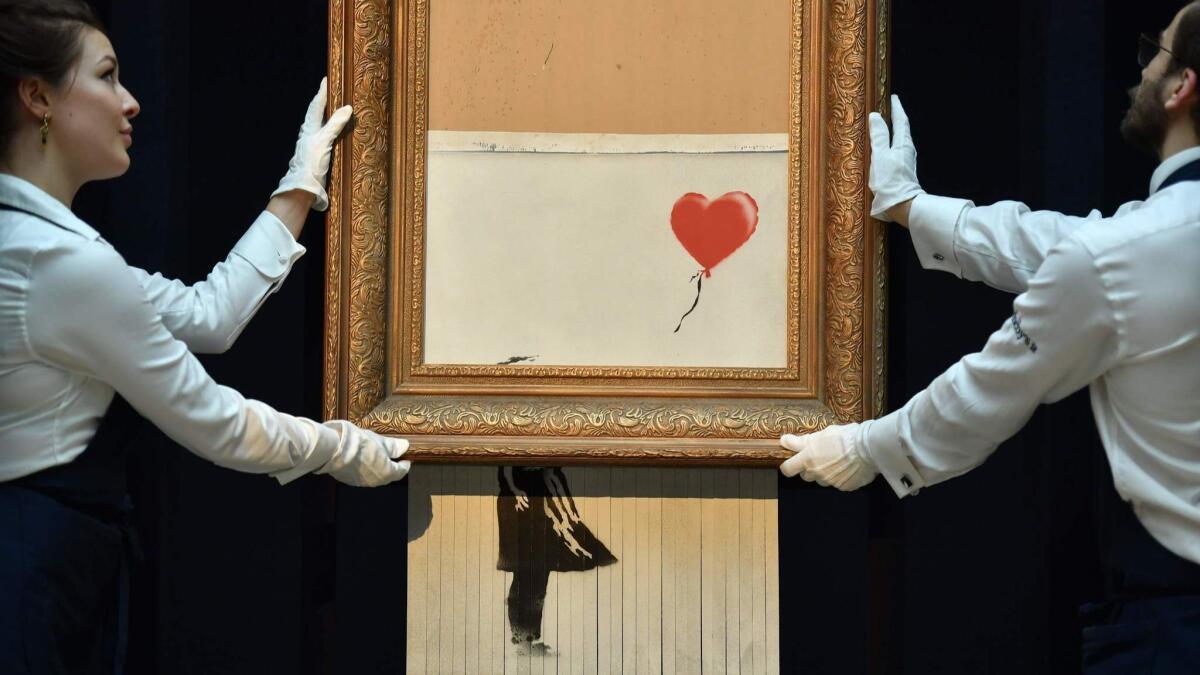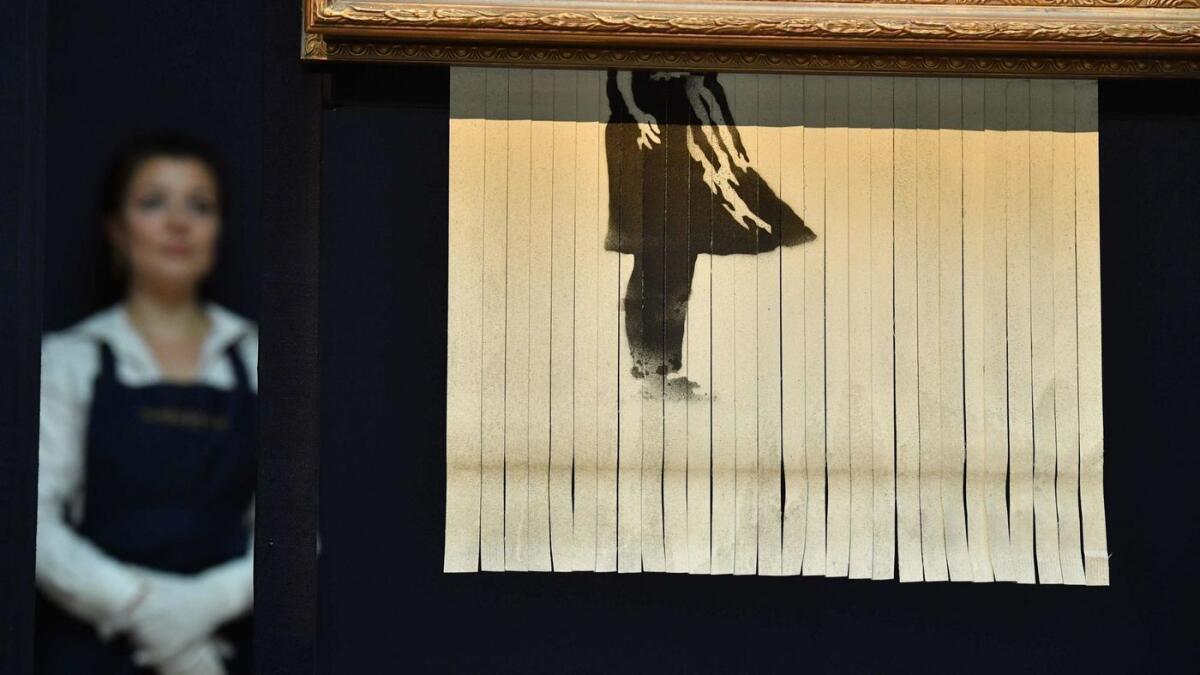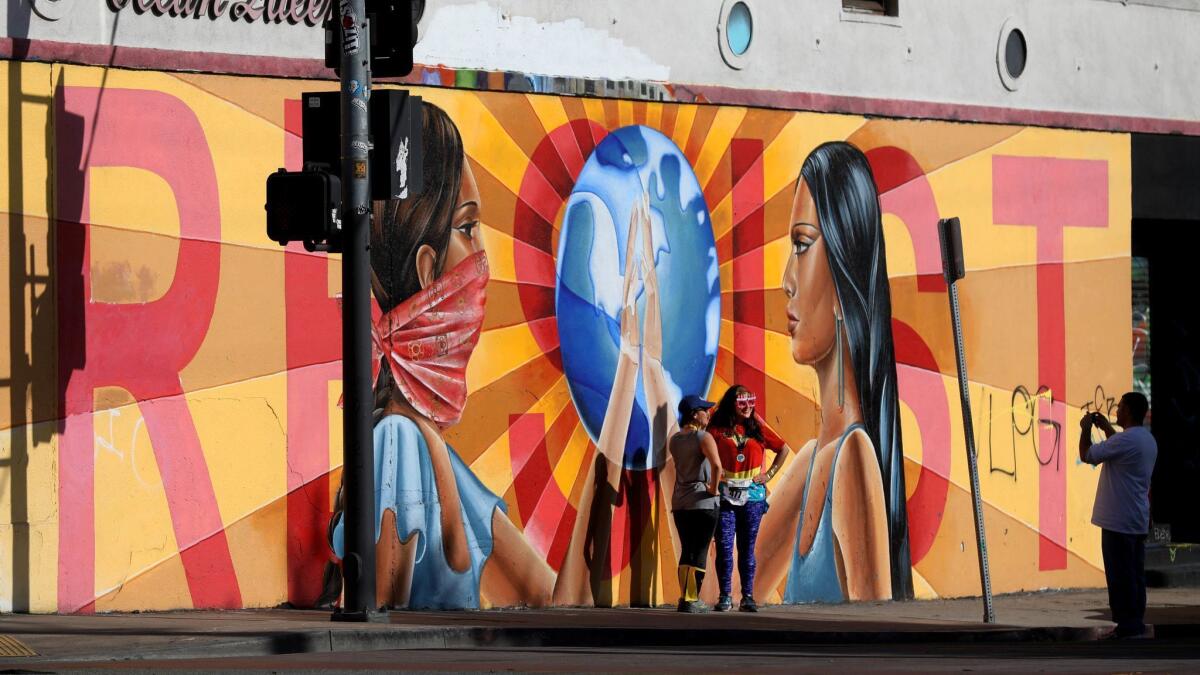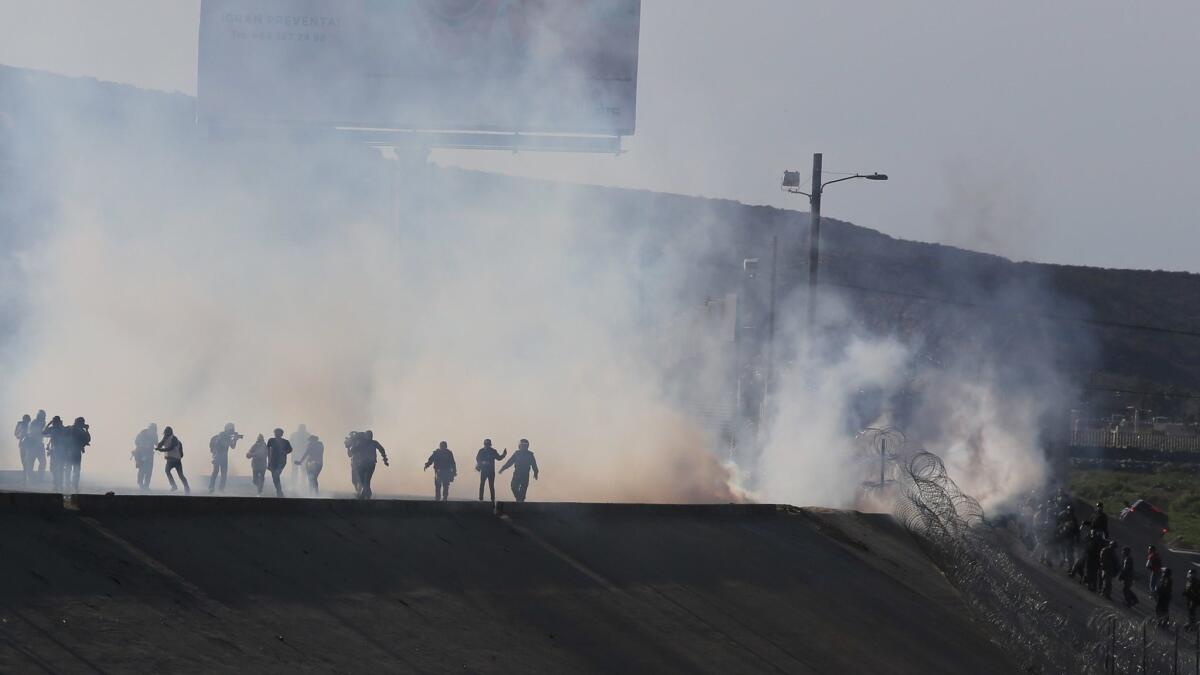Auctions, protests and controversial patrons: the three big ways art and money clashed in 2018

- Share via
In a cooly blunt scene from this fall’s art market documentary “The Price of Everything,” New York gallerist Gavin Brown offers his observations on the nature of art and money: “They are like Siamese twins — money and art,” he says. “You cannot separate them.”
It’s a link that is hardly new. To create his magnificent ceiling, Michelangelo required the patronage of Pope Julius, who often commissioned murals when he wasn’t busy subjugating Italian regions. Abstract Expressionist pioneer Jackson Pollock had some semblance of financial stability as an emerging artist because mining scion and bon vivant Peggy Guggenheim was paying the bills.
“There is no golden age without gold,” says L.A. curator Paul Schimmel in Nathaniel Kahn’s documentary. “Of course, it’s a bubble — bubbles make beautiful things.”
But bubbles pop — sometimes forcefully.
And in 2018, money and art have collided in incendiary and high-profile fashion. At a moment when there is a general reckoning about the ways in which political power is attained and wielded, so too is there a questioning of the uncomfortable connection between aesthetic ideals and the money that funds them. It was a year of auction house stunts and plenty of protest, when virality and public outrage made it impossible to ignore the source of it all.
Money (and some art) — a year in review:
The market loves a prank
It’s been a good year for the auction houses — at least in terms of the headlines. A work by Kerry James Marshall sold in May for $21 million, the most ever paid for a work by a living African American artist. In October, a portrait purportedly produced by artificial intelligence sold at Christie’s for almost a cool half mil. The following month, a painting by David Hockney set a record as the biggest sale ever for a living artist — $90 million, thank you very much.
The pièce de résistance, however, was Banksy’s viral auction house art shred in October. As the hammer went down on the $1.4 million sale of his 2006 stencil, “Girl with Balloon,” a mechanism in the frame was triggered and the work was shredded in full view of a surprised auction audience at Sotheby’s in London.
Hailed initially as “a rebuke of empty consumerism,” the sale — from an anonymous seller to an anonymous buyer — subsequently raised all kinds of questions: such as whether the auction house was involved in the prank. (Sotheby’s denied knowing about it in advance. Times art critic Christopher Knight, however, pointed out some anomalies, including the auctioneer’s placement of the artwork off on a side wall instead of front and center.)
Regardless, the stunt got relentless publicity for the artist and the auction house and the presumed buyer, described only as “a female European collector,” got a possibly more valuable work of art. In a statement, she said she was happy to keep the work now that it was a part of “art history.”
The story doesn’t end there. Two months later, L.A. artist Ron English made his own headlines when he acquired a piece of street art by Banksy at an auction in Beverly Hills — then vowed to whitewash it as a statement against the ways in which the market commodifies art that is made for the street. He was immediately deluged with offers to make money off the event.
Being anti-market, it turns out, is very marketable in 2018.

Art and gentrification
On a cool November night in 2015, a group of students from Boyle Heights staged an action on Mission Road in protest of the art galleries that had begun to materialize in the area. That protest — which included live painting and projections — was one of the early actions in an anti-gentrification movement that is still going strong.
Since then, groups such as Defend Boyle Heights and the Boyle Heights Alliance Against Artwashing and Displacement have targeted galleries — and their perceived connections to high-value patrons — as harbingers of gentrification. Urban planning studies show that things aren’t that simple: Galleries don’t cause development so much as mirror it. But the decision by anti-gentrification organizations to target artists and galleries plays on the status that art can hold in the popular imagination.
Art galleries are not monolithic. Most spaces, many run by artists, survive month to month. A successful few cater to the interests of the global jet set. But in an era of rising inequity — and relentless headlines about international art fairs, art-as-asset and multimillion-dollar auctions (see above) — art can be a shorthand for money.
The actions used in anti-gentrification struggles haven’t always been peaceable. Some galleries have reported death threats and others harassment. But the tactics have worked — and many art spaces in Boyle Heights left or closed in 2018, including Venus Los Angeles, 356 Mission, UTA Artist Space and Museum as Retail Space (known as M.A.R.S.). Even the Starz TV show “Vida,” which was noted for featuring a Latina activist fighting gentrification in Boyle Heights and has a Latina showrunner, found itself targeted by protesters — for gentrification.
The Boyle Heights scene may be cooling, but don’t expect anti-gentrification protests to go away. This year, similar protests have popped up in other L.A. neighborhoods — including West Adams and Historic South Central.

A look at the horse’s mouth
The image is by now indelible: a mother attempts to pull her children to safety as a tear gas canister explodes behind her, delivering a stinging white cloud into the air. It happened in November and was one of the more poignant images to emerge from the moment in which a caravan of Central American migrants was landing at the U.S.-Mexico border in Tijuana.
Days later, Jasmine Weber, a writer for the arts website Hyperallergic, revealed that the tear gas deployed on the border was manufactured by a company owned by Warren B. Kanders, the vice chairman of the Whitney Museum of American Art.
The news generated protests inside and outside the New York institution. In late November, Whitney staffers wrote an open letter condemning the museum’s silence on the matter. Then, earlier this month, protestors descended on the museum to call for Kanders’ ouster. (Beyond Whitney Museum Director Adam Weinberg writing a letter to the staff calling for more dialogue, no action has been taken.)
It’s not the first time that museum patronage has been called into question. Steven Mnuchin, who now serves as President Trump’s treasury secretary, was the subject of protests when he served on the board of the Museum of Contemporary Art Los Angeles in 2016 for his support of Trump and his role in the foreclosure crisis. (He resigned from MOCA’s board that year, when he joined the Trump administration.)
But this year has seen a more profound examination of the sources that museums turn to for funding. Another flashpoint: the killing of Jamal Khashoggi.
Best of 2018: A look back at the year in movies, TV, music and more »
When the Washington Post columnist was killed at the Saudi Arabian consulate in Turkey early this fall, cultural institutions that had been recipients of Saudi government largesse began to re-examine their financial ties to the kingdom. In October, the Metropolitan Museum of Art and the Brooklyn Museum of Art announced that they would not use Saudi government funds they had received for programs on Middle Eastern Art.
The story hits home in L.A., too. The Los Angeles County Museum of Art has an exhibition of works from its collection of Islamic art on view at the recently opened King Abdulaziz Center for World Culture in the Saudi city of Dhahran (a project that had been in the works since 2014). That exhibition is part of a two-year partnership with the center, which is funded by the Saudi national petroleum company, Saudi Aramco. A spokesperson for LACMA says the museum will not extend the partnership after the exhibition comes down in 2020 (though whether that is in response to Khashoggi’s killing is unclear).
In an essay in Hyperallergic about the situation at the Whitney, critic Carter Ratliff writes that the relationship between museums and their patrons is a fraught one: “Society honors museums as quasi-sacred spaces, repositories devoted to our loftiest values,” he writes. “Yet museums survive only with the help of wealthy individuals and institutions whose values, in some cases are far from lofty.”
Like Siamese twins, art and money may be inseparable. But they will occasionally pull in opposing directions.

ALSO
In 2018, female artists finally outnumbered men in L.A. museums’ solo shows
The 2018 cultural moment: The Kavanaugh hearing TV spectacle laid bare the country’s deep divisions
In 2018, prominent TV shows took a stand on #MeToo and its aftermath
In quiet yet visceral works, Zoe Leonard captures the frailty, pain and eccentricities of human life
Sign up for our weekly Essential Arts & Culture newsletter »
[email protected] | Twitter: @cmonstah
More to Read
The biggest entertainment stories
Get our big stories about Hollywood, film, television, music, arts, culture and more right in your inbox as soon as they publish.
You may occasionally receive promotional content from the Los Angeles Times.










